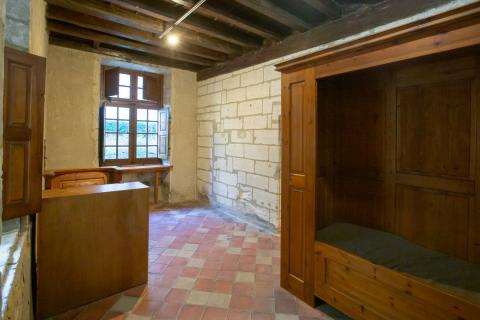
The rhythm of a day
Back in the fall, we spent a weekend in Avignon — yes, we danced sur le pont. We also biked out to La Chartreuse, a 13th century monastery today transformed into a centre for artists in residence. At its height around 1650, the Chartreux community here counted some 100 souls: 24 Pères, 30 Frères and fifty or so domestic and grounds workers. The higher-ranking monks each had a spacious ‘cell’ comprised of a sitting area with fireplace and a prayer desk, a study/sleeping room, a courtyard garden and a woodworking workshop on the second floor.
https://www.chartreuse.org/site/les-cellules-des-peres-chartreux
The Chartreux monks divided their time between prayer, reading, manual work (gardening or woodworking), resting and meals and collective prayer services – and still do in some twenty active Chartreux monasteries around the world, including the Grande Chartreuse near Grenoble. There’s something compelling about the order and rhythm of these daily practices, combining physical, mental and spiritual activities. Admittedly, the heavy emphasis on silence, prayer and solitude (20 hours a day are spent in that spacious ‘cell’) must limit participation to the most devout of souls.
A typical day in the life of a Cistercian monk (not the same order, but a similar schedule) looks like this (blue is for rest, yellow for prayer, orange for work and green for meals):
http://hg.moitel.free.fr/spip/IMG/pdf/f2_groupe_ro_le-socie_te_-med.pdf
There is an amazing and unusual liberty to my time this year. It feels luxurious beyond measure to be able to explore, following one thread after another in a giant web of interconnected issues, jumping between global issues and local engagement, studying philosophy and economics, music and nature. Maybe it’s in contrast to the amorphousness of my projects that I am also appreciating the idea and practice of daily rhythms: meditation, journaling, coffee, reading news, writing, walks, meetings, reading articles, writing, yoga, guitar, meals, reading novels, sleep.
Circadian rhythms are the ones that regulate our sleep-wake cycle in our bodies. We have two ‘dips’ in those rhythms – a morning one around 2-4 am and another in the early afternoon (nap time!). Research demonstrates that adolescent circadian rhythm is later than that of younger kids or adults, making it hard for them to fall asleep before 11 pm, with a morning circadian ‘dip’ that can last until 9 or 10, especially if they’re sleep deprived. The California legislature recently passed a bill to make middle and high schools start later, although it hasn’t been signed into law.
I know, from the class review committees I sit on in my son’s Collège (grades 6-10), that there are issues with some kids getting to school on time, especially when family situations are difficult. But there seem to be no plans afoot to change the French school schedules any time soon. Sinann leaves home most days at 7:30 in the dark, jogging down the forest and through the neighbourhood to begin school at 8. I get up with him out of a feeling of solidarity, and because it helps me start my daily rhythm.
A rhythm can also be about an idea we hold up to the light each day, each week, a lifetime. The wonderful Elizabeth Sheehan, executive director of Climate Smart Business, told me a few years ago that she had committed to performing two acts of kindness and one of rebellion each day. It stuck with me, and when I asked her about it recently, she wrote:
words are medicinal, poems in particular. To say, I usually have a phrase or poem or quote that carries me through the day, or week, few months even. At the time we spoke it was following the recent Trump victory in the US and I was struggling with how to rebel and not spiral into resistance as my only response. So, I came across this commitment to kindness – acts of kindness both as and a compliment to rebellion. Around the same time I came across this: Kindness – is love with its work boots on.
I love the idea of kindness as an act of rebellion, and of integrating challenges like this into daily rhythms, along with the activities that make up the pattern and rhythm of a day.